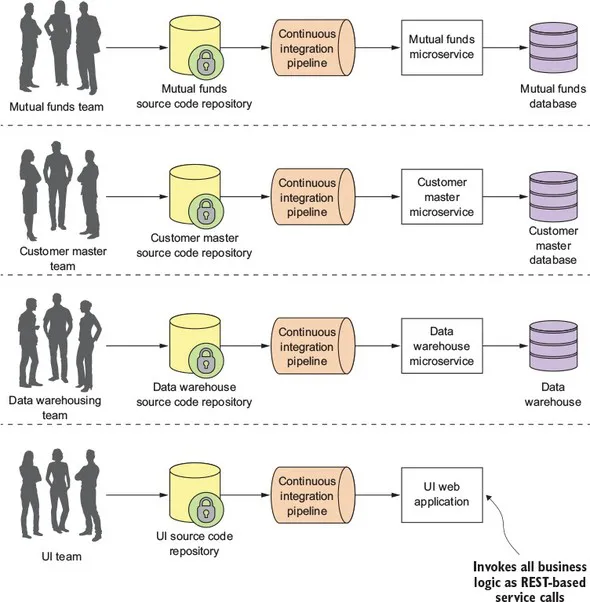
- 384 pages
- English
- ePUB (mobile friendly)
- Available on iOS & Android
Spring Microservices in Action
About this book
Summary Spring Microservices in Action teaches you how to build microservice-based applications using Java and the Spring platform. Purchase of the print book includes a free eBook in PDF, Kindle, and ePub formats from Manning Publications. About the technology Microservices break up your code into small, distributed, and independent services that require careful forethought and design. Fortunately, Spring Boot and Spring Cloud simplify your microservice applications, just as the Spring Framework simplifies enterprise Java development. Spring Boot removes the boilerplate code involved with writing a REST-based service. Spring Cloud provides a suite of tools for the discovery, routing, and deployment of microservices to the enterprise and the cloud. About the Book Spring Microservices in Action teaches you how to build microservice-based applications using Java and the Spring platform. You'll learn to do microservice design as you build and deploy your first Spring Cloud application. Throughout the book, carefully selected real-life examples expose microservice-based patterns for configuring, routing, scaling, and deploying your services. You'll see how Spring's intuitive tooling can help augment and refactor existing applications with micro services. What's Inside
- Core microservice design principles
- Managing configuration with Spring Cloud Config
- Client-side resiliency with Spring, Hystrix, and Ribbon
- Intelligent routing using Netflix Zuul
- Deploying Spring Cloud applications
About the Reader This book is written for developers with Java and Spring experience. About the Author John Carnell is a senior cloud engineer with twenty years of experience in Java. Table of contents
- Welcome to the cloud, Spring
- Building microservices with Spring Boot
- Controlling your configuration with Spring Cloud configuration server
- On service discovery
- When bad things happen: client resiliency patterns with Spring Cloud and Netflix Hystrix
- Service routing with Spring Cloud and Zuul
- Securing your microservices
- Event-driven architecture with Spring Cloud Stream
- Distributed tracing with Spring Cloud Sleuth and Zipkin
- Deploying your microservices
Frequently asked questions
- Essential is ideal for learners and professionals who enjoy exploring a wide range of subjects. Access the Essential Library with 800,000+ trusted titles and best-sellers across business, personal growth, and the humanities. Includes unlimited reading time and Standard Read Aloud voice.
- Complete: Perfect for advanced learners and researchers needing full, unrestricted access. Unlock 1.4M+ books across hundreds of subjects, including academic and specialized titles. The Complete Plan also includes advanced features like Premium Read Aloud and Research Assistant.
Please note we cannot support devices running on iOS 13 and Android 7 or earlier. Learn more about using the app.
Information
1. Welcome to the cloud, Spring
- Understanding microservices and why companies use them
- Using Spring, Spring Boot, and Spring Cloud for building microservices
- Learning why the cloud and microservices are relevant to microservice-based applications
- Building microservices involves more than building service code
- Understanding the parts of cloud-based development
- Using Spring Boot and Spring Cloud in microservice development
1.1. What’s a microservice?


- Application logic is broken down into small-grained components with well-defined boundaries of responsibility that coordinate to deliver a solution.
- Each component has a small domain of responsibility and is deployed completely independently of one another. Microservices should have responsibility for a single part of a business domain. Also, a microservice should be reusable across multiple applications.
- Microservices communicate based on a few basic principles (notice I said principles, not standards) and employ lightweight communication protocols such as HTTP and JSON (JavaScript Object Notation) for exchanging data between the service consumer and service provider.
- The underlying technical implementation of the service is irrelevant because the applications always communicate with a technology-neutral protocol (JSON is the most common). This means an application built using a microservice application could be built with multiple languages and technologies.
- Microservices—by their small, independent, and distributed nature—allow organizations to have small development teams with well-defined areas of responsibility. These teams might work toward a single goal such as delivering an application, but each team is responsible only for the services on which they’re working.
1.2. What is Spring and why is it relevant to microservices?
1While we cover REST later in chapter 2, it’s worthwhile to read Roy Fielding’s PHD dissertation on building ...
Table of contents
- Spring Microservices in Action
- Copyright
- Brief Table of Contents
- Table of Contents
- Preface
- Acknowledgments
- About this Book
- About the Author
- About the Cover Illustration
- 1. Welcome to the cloud, Spring
- 2. Building microservices with Spring Boot
- 3. Controlling your configuration with Spring Cloud configuration server
- 4. On service discovery
- 5. When bad things happen: client resiliency patterns with Spring Cloud and Netflix Hystrix
- 6. Service routing with Spring Cloud and Zuul
- 7. Securing your microservices
- 8. Event-driven architecture with Spring Cloud Stream
- 9. Distributed tracing with Spring Cloud Sleuth and Zipkin
- 10. Deploying your microservices
- Appendix A. Running a cloud on your desktop
- Appendix B. OAuth2 grant types
- Index
- List of Figures
- List of Tables
- List of Listings